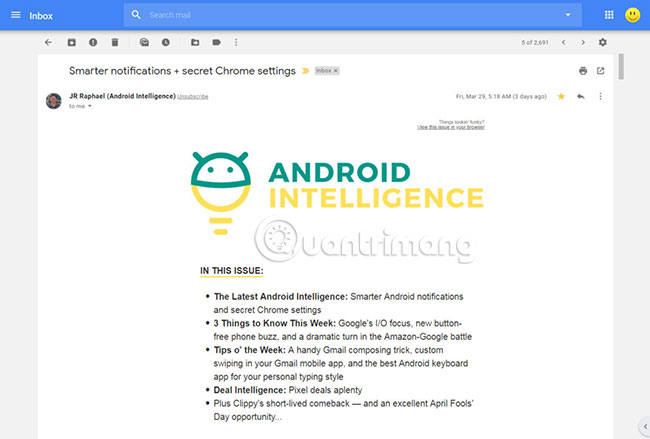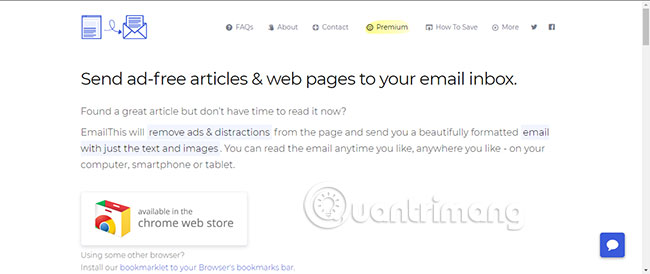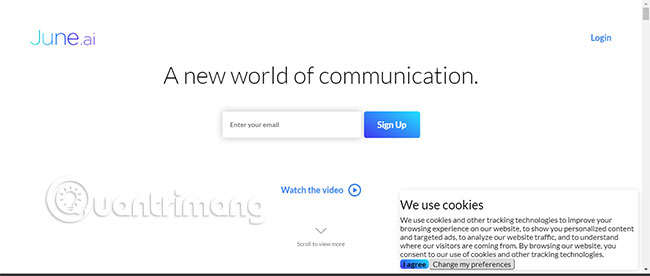How to put the Inbox interface into Gmail
Inbox by Gmail is coming to the last moments. Google will officially declare Inbox today. And even though as a user, there is nothing we can do to change this decision, but at least we can keep an important part of Inbox - the interface - on the desktop.
How to "revive" Inbox by Gmail
- Use the Inbox Theme for Gmail extension to bring the Inbox theme back
- "Revive" Inbox in Gmail
- Export each reminder in the Inbox to a new 'home'
- Save all previously saved posts
- Optimize Gmail inbox
- Think about announcements!
- Optimize Gmail Android application
- Consider third-party options
Use the Inbox Theme for Gmail extension to bring the Inbox theme back
Recently, an extension called Inbox Theme for Gmail has been released. This is a free extension on Chrome. All you have to do is install this utility, refresh the Gmail tab in the Chrome browser on the desktop.

Inbox has really looked like in Inbox by Gmail right now. The inbox seems to have been revived.
Do not hurry excited! This extension, literally, is just the interface for Gmail. It just looks like an Inbox on the surface. But below that, it's still just Gmail and most of the important Inbox power still doesn't appear.
The main effect of this theme is to bring the feeling when using the familiar Inbox before, from the main mail list view to the personal mail screen:

Unfortunately, this extension cannot bring the package system, responsible for organizing mail. Package system to classify mail and control when sent mail is being actively developed. The extension also does not provide an integrated reminder system, the system saves the inbox-based posts or additional Inbox shortcuts.
However, in addition to the package system (core, quite complex and difficult to simulate), most of the functional elements of Inbox can be reproduced without much effort.
"Revive" Inbox in Gmail
Export each reminder in the Inbox to a new 'home'
The first thing to do is to resolve the prompts, because many reminders only exist in the Inbox and will no longer be available when the application disappears.
Start by opening the Snoozed tab in the main menu of Inbox and viewing the displayed content. Any reported email will be redirected to Gmail and automatically appear at the right time. But all reminders will only appear as a temporary notification and are easily overlooked, if they are placed outside of Inbox, or will not appear at all, if they are placed in the app. The result is a confusing mess and it is impossible to predict what will happen if you accidentally miss an important reminder.
That's why you need to manually copy all pending reminders and then paste them as a new event in Google Calendar. You can mark the color of the prompt to make it easy to distinguish. After copying the prompt and saving to Google Calendar, delete it from Inbox to avoid confusion.
Any event in Google Calendar that starts with the phrase "Remember to" will automatically appear as a notification on the phone at the specified time - like any other event or reminder - but they will also appear as a special formatted item in your Gmail inbox and exist until you actively delete it, just like when you used the Inbox before.
Save all previously saved posts
Another Inbox feature that is lost during the conversion process is the ability to save articles and other web pages in the inbox, where they can be snoozed or searched like any other item. Any articles you have saved will be lost when 'Inbox' dies and Gmail has no equivalent system to save the new page.
Here's how to fix it: First, go to Inbox now and open the Saved section in the main menu. Open all saved articles and then think carefully about where you want to put them.
You can always move everything into a standalone service like Pocket (including Android apps and Chrome extensions). You can even save pages directly in Chrome, both on the desktop and from Android.
However, what makes the Inbox article storage feature so special is that it brings articles directly into the inbox - where users are able to see and process them (or report back on one day). or time set in advance). In contrast, standalone article archiving tools often turn only saved articles into dusty collections and even useful ones, but you accidentally forget and will never have a chance to read again.
If you want to keep the Inbox model intact and post articles directly to your inbox in Gmail, a service called Email This. This service even improves the sorting features of Inbox by offering unique formatted version links of the entire article to the inbox so you can read them and search again later. this. This service is free up to 20 times per month. There is a premium option that eliminates that limitation and adds advanced features such as the ability to attach notes to saved articles and create PDF snapshots of each saved page. Premium options are currently offered at a price of $ 19 / year (VND 430,000).

Optimize Gmail inbox
Gmail's desktop interface may look a bit like a mess. There are so many things going on and very few are effectively organized, compared to the minimalistic and reasonable system that you are used to using in Inbox.
First of all, you need to think about how you want to structure your inbox. Although previous reports have suggested that Inbox's package system will come to Gmail, it is only expected. It is better to find an alternative at the present time.
Try the inbox option under the Gmail tab. With a little tweaking, this option can really become quite useful.
Enable tabbed inbox feature, by hovering over the word "Inbox" in Gmail's left panel and clicking on the down arrow and selecting "Default". The tabbed inbox supports up to 5 automatically classified sections: Primary, Social, Promotions, Updates and Forums . Look at the email that is included in each section and think carefully about messages that really benefit you.
You can adjust your own tabs by adjusting the "Inbox" area in Gmail settings. There, you can uncheck any unwanted part - then click the "Save Changes" button and see how it affects mail sorting. Also, remember that you can tell Gmail certain types of emails by moving them manually when they are in the wrong category (or by creating filters, if you have the 'super' parameter). can and want to see changes immediately).
In the same installation area of Gmail, you can click on the "No markers" option in the heading "Importance markers" to remove the yellow arrows that cause confusion on the interface, but don't make much sense.
Think about announcements!
Don't forget that without Inbox, you'll have to configure Gmail to handle notifications any way you want. The Gmail Android application actually has a "high priority" notification mode simulated in Inbox, to detect really important mail and then only notify you of those messages. Or you can set up your own custom Gmail notifications based on the messages you need to notice immediately.
Either way, that's what to think about before making the transition.
Optimize Gmail Android application
The Gmail application on Android causes some 'annoying' by default. But with a few minutes of configuration, you can make Gmail much easier to use. You can also activate some shortcuts like Inbox, including swipe gestures from left to right to snooze.
Consider third-party options
If all this still makes you feel dissatisfied, there is still another option to consider: Choose a third-party service using Gmail as a 'backbone', such as June.

June is not a copy of Inbox, but it is built on many principles and provides some familiar features like Inbox. At its core, June separates emails into a primary inbox list for higher priority mail and personal mail, and a 'hidden' feed containing everything else. This feed can be viewed as a list or divided into categories such as news, finance, purchases, trips, etc.
You can even pin particularly important messages and then view them in a separate section. You can delete all parts of your feed with a single click of the "Clear" button .
This service is becoming more and more complete with the introduction of integrated snooze function and some tweaks to the interface and performance. However, although there are web apps, original Mac, Windows applications, and iOS apps, June still doesn't have an Android app. According to the roadmap, the Android app will be developed in 2019. The service is free and is committed to never selling or sharing any email data.
Don't feel lonely and desperate after the departure of Inbox by Gmail. If you really love this application, please apply the tips above to retain some beautiful memories of the Inbox until Google offers better alternatives.
Hope you are succesful.
 How to compact the Gmail interface with Simplify Gmail
How to compact the Gmail interface with Simplify Gmail How to customize the To-Do pane in Outlook
How to customize the To-Do pane in Outlook Why should Spark replace Google Inbox?
Why should Spark replace Google Inbox? How to schedule an automatic delivery of Gmail
How to schedule an automatic delivery of Gmail How to encrypt Gmail, Outlook and other webmail
How to encrypt Gmail, Outlook and other webmail How to receive Outlook notifications on the Desktop screen
How to receive Outlook notifications on the Desktop screen